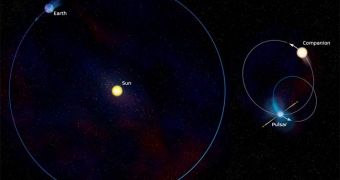Pulsars are a type of rapidly rotating neutron stars with powerful magnetic fields, capable of projecting a beam of electromagnetic radiation that sweeps the surrounding space as they rotate. They are usually found in the company of white dwarf stars, although the latest addition to the long list of pulsars seems to be orbiting a star in the same manner as our own planet, along an oval path.
Pulsars can complete a rotation around their axis in a period ranging between 1.5 milliseconds and 8.5 seconds. On the large scale, this is an incredibly small amount of time for an object with such a large mass to rotate around its axis. Pulsars gather momentum by conveying matter from red giant stars in their final stages of life. The red giant would eventually eject its outer layers and turn into a very compact star, known as white dwarf.
"The fact that it's around a sun-like star is fascinating because if that is the companion to this pulsar, then it certainly didn't accrete matter from that star ? it hasn't been a red giant yet", said David Champion, an astronomer at Canada's McGill University.
Scientists say that the strange object, dubbed PSR J1903+0327, could have arrived in the company of the Sun-like star after being ejected from a globular cluster during gravitational interactions with another stellar object.
"The reason why we're so excited about this is the impact it might have on our understanding of where the pulsars that we look at are coming from. We've never seen anything like this before", said Champion.
Pulsar stars are born when massive stars reach the end of their lives and turn 'nova'. However, instead of producing a white dwarf star the explosion causes the collapse of the core. The gravitational field is not powerful enough to create a black hole, but it can convert all protons and electrons into neutrons, thus creating a neutron star. Neutron stars usually bear powerful magnetic fields confined in a small area of space. Any particles around the star, trapped in this magnetic field would then be forced to emit radiation in a focused beam, aligned to the magnetic field lines of the star.
The rotation of the star causes the radiation beam to sweep the space surrounding it much in the same way the light from a lighthouse does. On Earth, astronomers register this effect as a pulse coming in our direction, therefore the name pulsar star.
In time, pulsar stars lose momentum as they rotate. As we said earlier, they can complete a rotation around their axis in as little as 1.5 milliseconds. PSR J1903+0327 rotates every 2.15 milliseconds, probably due to the fact that it might have pulled material from a red dwarf stellar companion through a process called by scientists 'recycling'. When this happens, the pulsar stabilizes its orbit as a circular one around a white dwarf star.
The team that made the discovery believes that the newly found pulsar originated in a globular star cluster and at the time it was ejected from the system it was going through a recycling process by drawing material from is red dwarf companion. Alternatively, the strange behavior of this particular pulsar could be accounted for if it originated in a triple star system, where the red giant companion was destroyed, leaving behind only the Sun-like star.
"It's always the most unusual objects that advance our understanding the most in these cases", Champion said.

 14 DAY TRIAL //
14 DAY TRIAL //